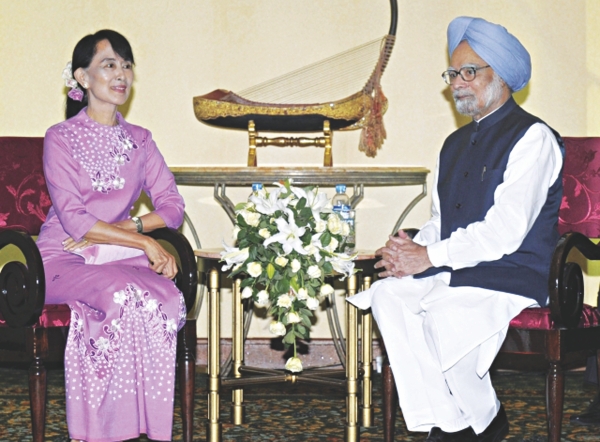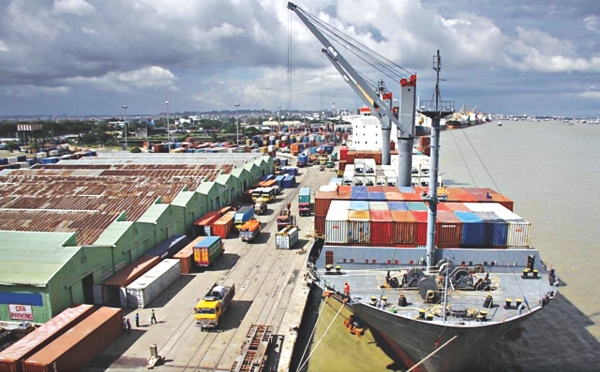
Inside
Original Forum |
| The Blunder Game -- Shakhawat Liton |
| Why Police are more Equal in Bangladesh -- Rifat Munim |
| Do we have an Independent Judiciary? -- Dr. Zahidul Islam Biswas |
| The Grameen Saga: A Nation's Bank of Pride -- Reaz Ahmad |
| The Rail Solution -- Asjadul Kibria |
Regional trade: Moving Towards Change --- Refayet Ullah Mirdha |
Popularising Science Education |
Enabling Entrepreneurial Ecosystems -- Susan Davis |
Rape in 1971 -- an Act of Genocide -- Buddhadeb Halder |
| The Madness that is Cinema -- Kajalie Shehreen Islam |
| When country overwhelms city -- Seema Nusrat Amin |
| Chile 1973, End of a Dream -- Syed Badrul Ahsan |
Regional trade: Moving Towards Change
REFAYET ULLAH MIRDHA envisions a boost in regional trade and commerce following the recent political reforms in Myanmar.
With the changes of political situation in the South Asian region, some new regional trade opportunities have lately been created for most of the countries in the region. Bangladesh is already enjoying some benefits of overseas trade due to those changes. However, it has vast opportunities to draw more trade benefits given that regional cooperation continues to grow.
A new opportunity of regional cooperation (Bangladesh, India and Myanmar cooperation) is opening up in South Asia for the ongoing political reforms in Myanmar under the administration of Thein Sein. As a result, Myanmar is becoming more and more accessible to other countries and Bangladesh, being a neighbouring country, has an extraordinary accessibility to this resourceful country. After a long period of military rules, Myanmar is now opening its door for foreign trade and investment.
 Star Photo
Star Photo
Many countries are now in negotiation with Myanmar for establishing trade links. Even the US Secretary of State, Hillary Rodham Clinton paid an official visit to Myanmar last December, which has a great significance for the country and its neighbours. Bangladeshi Prime Minister Sheikh Hasina also paid an official visit to Myanmar last year mainly to open up the business opportunities between the two countries.
It is not surprising that India, a very influential neighbour of Myanmar, launched a $70million project for establishing people to people contact especially through establishing physical infrastructures between the countries. According to Indian Foreign Minister SM Krishna, most of the amount will be spent on road network between India and Myanmar mainly for more trade and investment.
The objective of writing this article is to show how immensely Bangladesh can also be benefited from these regional trade opportunities. Of course, Bangladesh has a very important stake in this tri-national trade linkage for its geographical location. At present, in spite of being one of the closest neighbours, the trade between Bangladesh and Myanmar is very minimal as the regional trade record among the South Asian nations is poor.
In the bilateral trade balance, the trade is heavily tilted in favour of Myanmar as Bangladesh imports foodstuffs and other basic commodities from Myanmar. Data from the commerce ministry shows that in 2010-11 fiscal year Bangladesh imported goods worth $179.00 million and exported goods worth $9.65million. Data also shows that in 2009-10 fiscal year Bangladesh imported goods worth $69.61million and exported goods worth $10.04 million.
So, the trade is in favour of Myanmar, although Bangladesh has the potentials for increasing the trade balance. An important development in trade between Myanmar and Bangladesh took place last year, when both the governments introduced direct LC opening for more trade. Earlier, only $50,000 was allowed from Bangladesh from a branch of Sonali Bank at Teknaf Landport for each consignment.
But now, businessmen of both the countries can open an LC (letter of credit) for any quantity of dollars as the restriction has already been removed through mutual understanding. Interestingly enough, there is no formal shipping agreement between the two countries, although both the governments are at the final stage of negotiating formal shipping lines between the two countries.
Businessmen are expecting a formal announcement during the upcoming visit of Thein Sein in Bangladesh. His arrival in Dhaka has already been deferred two or more times for different causes. If, the formal shipping line is established between Bangladesh and Myanmar, the trade is expected to increase manifold.
I have already hinted a bit about the objective of writing this article. I have also showed that India's interest for boosting trade with Myanmar has already run into a project. But Bangladesh, for its strategic locations, occupies an important place for any business to be held between India and Myanmar. So, my main objective of writing the article is to show how a tri-national cooperation among Bangladesh, India and Myanmar can bring trade benefit for this region.
 Anurup Kanti Das
Anurup Kanti Das
Before writing on tri-national trade opportunity, let us have a little focus on bilateral trade between Bangladesh and India and the current trade situation among the SAARC (South Asian Association for Regional Cooperation) nations. India as a new export destination has become more potential when the Congress-led UPA government declared duty-free facility to almost all Bangladeshi items except those of 25 alcoholic beverages and drugs.
The export of garment items from Bangladesh to India is increasing rapidly as the growing middle-class Indians depend more on Bangladeshi garment products for the price competitiveness. During his visit to Bangladesh last September, Indian Prime Minister Manmohan Singh declared duty-free garment export to India from Bangladesh. With the growth of garment export to India, the ever-widening trade gap between the two countries will definitely minimise a bit.
According to data from the Export Promotion Bureau (EPB) and Bangladesh Bank (BB), Bangladesh exported goods worth $498.42 million to India in July-May period of the immediate past fiscal year and imported goods worth $4.40 billion during the same period. The data also showed that Bangladesh imported goods worth $4.57 billion and exported goods worth $512.50 million in 2010-11 fiscal.
The intra-regional trade under the Saarc umbrella is more than 4 percent while trade among the Asean countries is nearly 40 percent. Myanmar is a member of the ASEAN, formed in 1967, and it is expected that the country will chair the association from 2014. But the Saarc countries have yet to cash in on the trade potentials among them.
Currently, there is no separate trade umbrella exclusively for the three nations. Each country has a separate bilateral trade arrangement with each other. But the three nations are members of some wider trade associations like Bay of Bengal Initiative for Multi-sectoral Technical and Economic Cooperation (BIMSTEC) and Kunming Initiative.
Kunming Initiative comprising China, India, Bangladesh and Myanmar was formed for having more interactions and connectivity among the participating countries in all spheres like business and infrastructural development.
Ideally, the tri-nation trade umbrella is needed mainly to have a balance in regional trade. Being closest neighbours having considerable stretches of common border, the trio can hardly ignore the importance of one another. The trade initiatives among the trio will also help reduce regional poverty for having a mutual understanding. Such understanding in turn will help establish peace and security in this region. India, being the largest country having more than one billion population and an emerging economic power, will enjoy majority of the trade benefit from the regional trade.
Such unilateral benefit enjoyed by India might create an imbalance in trade facilitation regionally. But, if the trade could be shared among the regional countries, all three nations will be benefited in a balanced way. It is worth-mentioning here that ASEAN-India trade has already reached the target of $70 billion and the next target is set at $80 billion mark. The ASEAN-India trade grew by 37 percent in 2011-12 fiscal, thanks to different media reports. So, the trade between ASEAN-India is growing at a faster rate, which has a significant value regionally.
Particularly, since the trio is a group of economically emerging nations and has common bordering areas, there should have a very vibrant trade networks also for future development. Moreover, if India joins the 10-nations ASEAN league in future, Bangladesh will be in isolation at least in terms of trade, with the South-Eastern countries. Negotiation is underway for India joining the ASEAN. If the trio can form a separate trading umbrella, all the three countries will be able to enjoy trade benefits jointly.
For Bangladesh and India, Myanmar is a gateway to enter into other east Asian countries. The trade facilitation among the three nations might bring good business potentials for the area. Construction of road network among the three nations will reduce trade costs significantly. If a new trade umbrella could be formed, all the three nations could use the seaports, which will reduce the trade costs.
Myanmar is a resourceful country and it is also rich in food production. If the three nations could ink a cooperation deal, they will be able to share energy and could ensure food security for the people of this region. In view of all the prospects, the three nations should join hands with one another so that a peaceful region could be established.
Refayet Ullah Mirdha is Business Correspondent, The Daily Star.